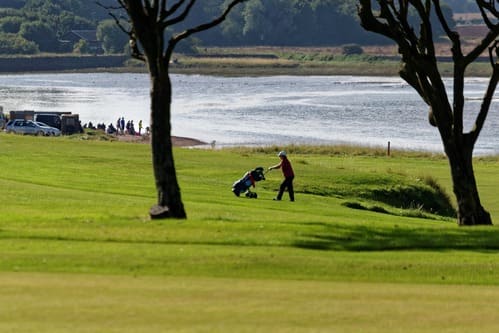Golf is a beloved sport enjoyed by millions worldwide. The question of how far you walk in a round of golf is a common inquiry among players, whether they are casual enthusiasts or dedicated professionals. In this article, we will delve into the intricacies of a golf round, exploring the distances covered across various types of courses and shedding light on the physical demands involved.
Quick Answer: How Far Do You Walk in a Round of Golf?
According to the World Golf Foundation, golfers who choose to walk an 18-hole course typically cover approximately 5-6 miles (8-10 km) and can burn up to 2,000 calories during their round.
The Golf Course: An Expansive Playground
Before we can determine how far you walk in a round of golf, it is essential to understand the layout and design of a typical golf course. These sprawling landscapes vary in size and terrain, often encompassing vast stretches of land with diverse features. From undulating fairways and meticulously manicured greens to strategically placed hazards, each course offers a unique challenge.

Exploring the Distances: Tee to Green
In golf, the distance covered by a player begins right from the tee box. As golfers stand on the tee, they survey the hole ahead and plan their shot. From the initial drive, players navigate their way through a series of fairways, aiming to reach the green in as few strokes as possible. The total distance traveled from the tee to the green is known as the “tee-to-green” distance.
The Fairways: A Pathway of Precision
Fairways serve as the primary routes connecting the tees to the greens. These meticulously maintained strips of closely cut grass provide golfers with a clear path to follow. While walking along the fairway, players often find themselves measuring the distance to their next shot, strategizing their approach, and occasionally retrieving their ball from errant shots.
Navigating the Greens: Delicate Steps
Upon reaching the green, golfers shift their focus to precision and finesse. The green is where the hole is located, and players aim to sink their putts to complete each individual hole. While the distances on the greens are relatively short compared to the fairways, the intricacies of reading the greens and gauging the slope and speed of the surface require utmost concentration.
The Distances in Numbers: A Statistical Analysis
To provide a more concrete understanding of the distances covered during a round of golf, let’s examine some statistics.
Here are the top 10 golf courses in the USA as ranked by NationalClubGolfer.com along with their course yardage.
| Golf Course | State | Yardage | Par |
|---|---|---|---|
| Pine Valley | New Jersey | 7181 | 70 |
| Cypress Point | California | 6524 | 72 |
| Shinnecock Hills | New York | 7445 | 70 |
| Augusta National | Georgia | 7475 | 72 |
| National Golf Links of America | New York | 6935 | 72 |
| Sand Hills | Nebraska | 7089 | 71 |
| Oakmont | Pennsylvania | 7255 | 71 |
| Merion East | Pennsylvania | 6996 | 70 |
| Pebble Beach | California | 7075 | 72 |
| Fisher’s Island | Connecticut | 6615 | 70 |
The average yardage of these beautiful golf courses is 7059 yards.
However, it’s worth noting that the length of a course can vary significantly, and professional tournaments often feature longer layouts.
It’s important to note that you will always walk further than the stated yardage of a course. You will never walk a dead straight line from the tee to the pin! There is also the added distance from the green of one hole to the tee box of the next. This is never included in total yardage statistics.
You should expect to walk 50-80% further than the stated yardage of any given course.
Walking vs. Riding Carts: The Impact on Distance

When discussing the distance covered in golf, it is crucial to consider the mode of transportation. Many golfers choose to ride in golf carts, which significantly reduces the physical exertion required. However, for those who opt to walk, the distances covered are much greater. Walking not only contributes to a healthier lifestyle but also adds to the overall experience and connection with the course.
Factors Affecting Distance: Course Design and Layout
The distance covered during a round of golf is heavily influenced by the course’s design and layout. Courses with longer holes, wider spacing between greens and tees, and substantial distances between adjacent holes naturally require more walking. On the other hand, compact courses with shorter distances between holes offer a condensed experience.
The Health Benefits of Walking in Golf
Walking in golf provides numerous health benefits. It promotes cardiovascular fitness, strengthens muscles, improves balance and coordination, and aids in weight management. This is mostly as you can burn up to 2000 calories by walking a round of golf!
Additionally, walking allows golfers to immerse themselves in the beautiful surroundings, appreciate nature, and enjoy a sense of tranquility as they traverse the course.
FAQs
How many miles do you walk in 18 holes?
On average, golfers can expect to walk around 5 miles during an 18-hole round.
How many kilometers do you walk in 18 holes of golf?
In terms of kilometers, walking 18 holes of golf is approximately 8-10 kilometers.
How many steps do you walk in 18 holes of golf?
The number of steps taken during 18 holes of golf can vary, but it is estimated to be around 10,000-12,000 steps.
How many calories are burned walking 18 holes of golf?
Walking 18 holes of golf can burn approximately 1,200-2,000 calories, depending on factors such as body weight, terrain, and pace.
Does golf count as cardio?
Yes, golf can be considered a form of cardiovascular exercise as it involves walking, swinging clubs, and engaging in physical activity that raises the heart rate.
Final Thoughts
In conclusion, the distance covered in a round of golf varies depending on various factors such as course design, layout, and personal choice of transportation. Whether you choose to walk or ride a golf cart, the experience of playing this remarkable sport is a harmonious blend of physical exertion, mental focus, and a deep appreciation for the game’s rich traditions.






